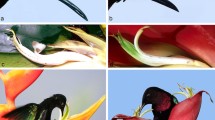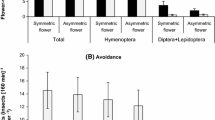Abstract
Flower herbivory and pollination have been described as interactive processes that influence each other in their effects on plant reproductive success. Few studies, however, have so far examined their joint effects in natural populations. In this paper we evaluate the influence of flower damage and pollination by the hummingbird Oreotrochilus leucopleurus on the fecundity of the Andean monkey flower Mimulus luteus. We performed a 2×2 factorial experiment, with artificial clipping of lower petals and selective exclusion of the hummingbird as main factors. In spite of the relatively low proportion (27.5%) of the variance in seed production accounted for by the full factorial model, artificial damage and hummingbird exclusion, as well as their interaction, were highly significant, indicating nonadditive effects of factors on plant fecundity. In the presence of hummingbirds, undamaged flowers had a seed production that was 1.7-fold higher than for damaged flowers, suggesting that the effect of flower damage on female reproductive success occurs probably as a consequence of hummingbird discrimination against damaged corollas. This result indicates that the impact of flower herbivory on plant fecundity was contingent on the presence or absence of hummingbirds, suggesting that pollinators may indirectly select for undamaged and probably resistant flower phenotypes. A second interaction effect revealed that undamaged flowers produced 78.5% more seeds in the absence of rather than in the presence of O. leucopleurus, raising the question of the ecological mechanism involved. We suggest that the strong territorial behavior exhibited by the bee Centris nigerrima may confine the foraging activities of the remaining bee species to safe sites within exclosures. Overall, our results provide evidence that hummingbird pollination and flower herbivory have interdependent effects on M. luteus fecundity, which indicates that it will be difficult to predict their ecological and evolutionary consequences unless interactions are analyzed in an integrated form.



Similar content being viewed by others
References
Alcock J, Jones CE, Buchmann CL (1977) Male mating strategies in the bee Centris pallida Fox (Anthophoridae: Hymenoptera). Am Nat 111:145–155
Armbruster WS (1997) Exaptations link evolution of plant–herbivore and plant–pollinator interactions: a phylogenetic inquiry. Ecology 78:1661–1672
Armbruster WS (2002) Can indirect selection and genetic context contribute to trait diversification? A transition-probability study of blossom-colour evolution in two genera. J Evol Biol 15:468–486
Beardsley PM, Olmstead RG (2002) Redefining Phrymaceae: the placement of Mimulus, tribe Mimuleae, and Phryma. Am J Bot 89:1093–1102
Bertness MD, Shumway SW (1992) Consumer driven pollen limitation of seed production in marsh grasses. Am J Bot 79:288–293
Botto-Mahan C, Pohl N, Medel R (2004) Nectar guide fluctuating asymmetry does not relate to female fitness in Mimulus luteus. Plant Ecol 174:347–352
Brody AK (1992) Oviposition choices by a pre-dispersal seed predator (Hylemya sp.). Oecologia 91:56–62
Canela MBF, Sazima M (2003) Florivory by the crab Armases angustipes (Grapsidae) influences hummingbird visits to Aechmea pectinata (Bromeliaceae). Biotropica 35:289–294
Chittka L, Thomson JD (2001) Cognitive ecology of pollination: animal behavior and floral evolution. Cambridge University Press, Cambridge
Cunningham SA (1995) Ecological constraints on fruit initiation by Calyptrogyne ghiesbreghtiana (Arecaceae): floral herbivory, pollen availability, and visitation by pollinating bats. Am J Bot 82:1527–1536
Ehrlén J (1997) Risk of grazing and flower number in a perennial plant. Oikos 80:428–434
Ehrlén J (2002) Assessing the lifetime consequences of plant–animal interactions for the perennial herb Lathyrus vernus (Fabaceae). Perspect Plant Ecol Evol Syst 5:145–163
English-Loeb GM, Karban R (1992) Consequences of variation in flowering phenology for seed head herbivory and reproductive success in Erigeron glaucus (Compositae). Oecologia 89:588–595
Ewald PW, Carpenter FL (1978) Territorial responses to energy manipulations in the Anna hummingbird. Oecologia 31:277–292
Feinsinger P (1976) Organization of a tropical guild of nectarivorous birds. Ecol Monogr 46:257–291
Fineblum WL, Rausher MD (1997) Do floral pigmentation genes also influence resistance to enemies? The W locus in Ipomoea purpurea. Ecology 78:1646–1654
Frazee J, Marquis R (1994) Environmental contribution to floral trait variation in Chamaecrista fasciculate (Fabaceae: Caesalpinoideae). Am J Bot 81:206–215
Galen C, Cuba J (2001) Down the tube: pollinators, predators, and the evolution of flower shape in the alpine skypilot, Polemonium viscosum. Evolution 55:1963–1971
Gass CL, Montgomerie RD (1981) Hummingbird foraging behavior: decision-making and energy regulation. In: Kamil AC, Sargent TD (eds) Foraging behavior: ecological, ethological, and psychological approaches. Garland STPM Press, New York, pp 159–194
Gill FB, Mack AL, Ray RT (1982) Competition between hermit hummingbirds Phaethorninae and insects for nectar in a Costa Rican rain forest. Ibis 124:44–49
Gómez JM (2005) Non-additive effects of herbivores and pollinators on Erysimum mediohispanicum (Cruciferae) fitness. Oecologia 143:412–418
Hendrix SD, Trapp EJ (1989) Floral herbivory in Pastinaca sativa: do compensatory responses offset reductions in fitness? Evolution 43:891–895
Herrera CM (2000) Measuring the effects of pollinators and herbivores: evidence for non-additivity in a perennial herb. Ecology 81:2170–2176
Herrera CM, Medrano M, Rey PJ, Sanchez-Lafuente AM, Garcia MB, Guitian J, Manzaneda AJ (2002) Interaction of pollinators and herbivores on plant fitness suggests a pathway for correlated evolution of mutualism- and antagonism-related traits. Proc Natl Acad Sci USA 99:16823–16828
Hixon MA, Carpenter FL, Paton DC (1983) Territory area, flower density, and time budgeting in hummingbirds: an experimental and theoretical analysis. Am Nat 122:366–391
Irwin RE (2000) Hummingbird avoidance of nectar-robbed plants: spatial location or visual cues. Oikos 91:499–506
Irwin RE, Strauss SY, Storz S, Emerson A, Guibert G (2003) The role of herbivores in the maintenance of a flower color polymorphism in wild radish. Ecology 84:1733–1743
Karban R, Strauss SY (1993) Effects of herbivores on growth and reproduction of their perennial host, Erigeron glaucus. Ecology 74:39–46
Kelly CA, Dyer RJ (2002) Demographic consequences of inflorescence-feeding insects for Liatris cylindracea, an iteroparous perennial. Oecologia 132:350–360
Krupnick GA, Weis AE, Campbell DR (1999) The consequences of floral herbivory for pollinator service to Isomeris arborea. Ecology 80:125–134
Laverty TM, Plowright RC (1985) Competition between hummingbirds and bumblebees for nectar in flowers of Impatiens biflora. Oecologia 66:25–32
Leege LM, Wolfe LM (2002) Do floral herbivores respond to variation in flower characteristics in Gelsemium sempervirens (Loganiaceae), a distylous vine?. Am J Bot 89:1270–1274
Lehtilä K, Strauss SY (1999) Effects of foliar herbivory on male and female reproductive traits of wild radish, Raphanus raphanistrum. Ecology 80:116–124
Lohman DJ (1996) Impact of floral herbivory by parsnip webworm (Oecophoridae: Depressaria pastinacella Duponchel) on pollination and fitness of wild parsnip (Apiaceae: Pastinaca sativa L.). Am Midl Nat 136:407–412
Malo JE, Leirana-Alcocer J, Parra-Tabla V (2001) Population fragmentation, florivory, and the effects of flower morphology alterations on the pollination success of Myrmecophila tibicinis (Orchidaceae). Biotropica 33:529–534
Medel R, Botto-Mahan C, Kalin-Arroyo M (2003) Pollinator mediated selection on the nectar guide phenotype in the Andean monkey flower, Mimulus luteus. Ecology 84:1721–1732
Møller AP (1995) Bumblebee preference for symmetrical flowers. Proc Natl Acad Sci USA 92:2288–2292
Møller AP, Eriksson M (1995) Pollinator preference for symmetrical flowers and sexual selection in plants. Oikos 73:15–22
Mothershead K, Marquis RJ (2000) Fitness impacts of herbivory through indirect effects on plant–pollinator interactions in Oenothera macrocarpa. Evolution 81:30–40
Murawski DA (1987) Floral resource variation, pollinator response, and potential pollen flow in Psiguria warscewiczii. Ecology 68:1273–1282
Primack RB, Howe HF (1975) Interference competition between a hummingbird (Amazilia tzacatl) and skipper butterflies (Hesperiidae). Biotropica 7:55–58
Quesada M, Bollman K, Stephenson A (1995) Leaf damage decreases pollen production and hinders pollen performance in Cucurbita texana. Ecology 76:437–443
Raw A (1975) Territoriality and scent marking by Centris males (Hymenoptera, Anthophoridae) in Jamaica. Behaviour 54:311–332
Sandlin EA (2000) Foraging information affects the nature of competitive interactions. Oikos 91:18–28
Schaefer HM, Schaefer V, Levey DJ (2004) How plant–animal interactions signal new insights in communication. Trends Ecol Evol 19:577–584
Schemske DW, Horvitz CC (1988) Plant–animal interactions and fruit production in a neotropical herb: a path analysis. Ecology 69:1128–1137
Siikamäki P, Lammi A, Mustajärvi K (2002) No relationship between fluctuating asymmetry and fitness in Lychnis viscaria. Evol Ecol 16:567–577
Silander JA (1978) Density-dependent control of reproductive success in Cassia biflora. Biotropica 10:292–296
Stoaks RD (2000) Foraging interactions at a hummingbird feeder: conflicts of the Anna hummingbird (Aves: Trochilidae) and the prairie yellowjacket (Hymenoptera: Vespidae). Sociobiology 35:49–62
Strauss SY (1991) Indirect effects in community ecology: their definition, study and importance. Trends Ecol Evol 6:206–210
Strauss SY (1997) Floral characters link herbivores, pollinators and plant fitness. Ecology 78:1640–1645
Strauss SY, Irwin RE (2004) Ecological and evolutionary consequences of multispecies plant–animal interactions. Annu Rev Ecol Evol Syst 35:435–466
Strauss SY, Conner JK, Rush SL (1996) Foliar herbivory affects floral characters and plant attractiveness to pollinators: implications for male and female plant fitness. Am Nat 147:1098–1107
von Bohlen C (1995) El género Mimulus L. (Scrophulariaceae) en Chile. Gayana Bot 52:7–28
Waser NM (1983) The adaptive nature of floral traits: ideas and evidence. In: Real L (eds) Pollination biology. Academic, Florida, pp 241–285
Waser NM, Price MV (1985) The effect of nectar guides on pollinator preference: experimental studies with a montane herb. Oecologia 67:121–126
Wilcox CD, Dove SB, McDavid WD, Greer DB (2000) UTHSCSA image tool for Windows, version 2.01. University of Texas Health Science Center, San Antonio, TX
Acknowledgments
We thank D. Cotoras, M. Espinoza, D. Medel, J. Mpodozis, C. Pino, M.V. Lopez and P. Sabat for their collaboration at different stages of this research. This study was part of the activities of the Center for Advanced Studies in Ecology and Research in Biodiversity, P02-051-F ICM. This research was partially funded by grants PG/55/02 (DID, Universidad de Chile) to NP, and FONDECYT 1050199 to RM.
Author information
Authors and Affiliations
Corresponding author
Additional information
Communicated by Jacqui Shykoff
Rights and permissions
About this article
Cite this article
Pohl, N., Carvallo, G., Botto-Mahan, C. et al. Nonadditive effects of flower damage and hummingbird pollination on the fecundity of Mimulus luteus . Oecologia 149, 648–655 (2006). https://doi.org/10.1007/s00442-006-0479-z
Received:
Accepted:
Published:
Issue Date:
DOI: https://doi.org/10.1007/s00442-006-0479-z




